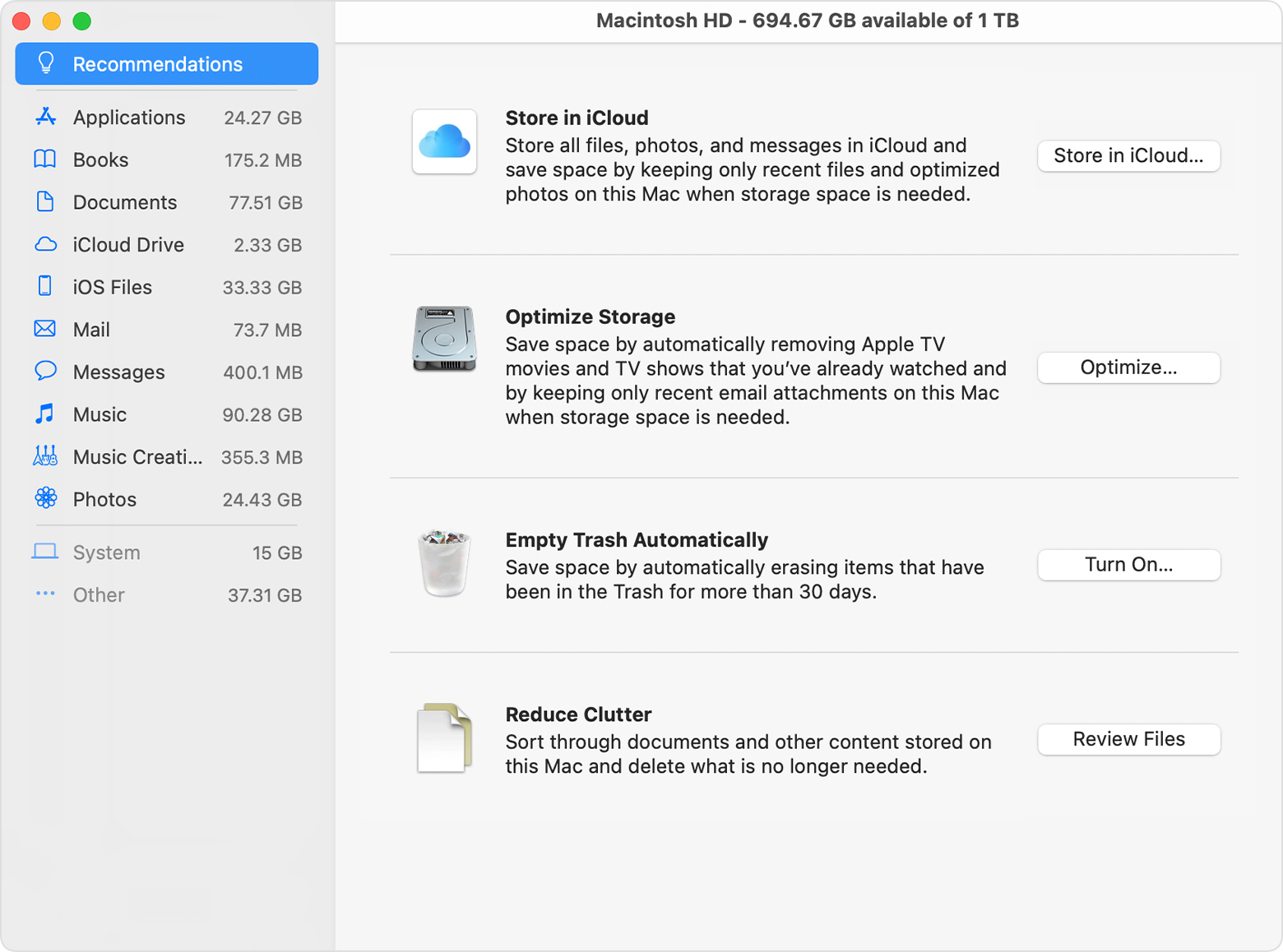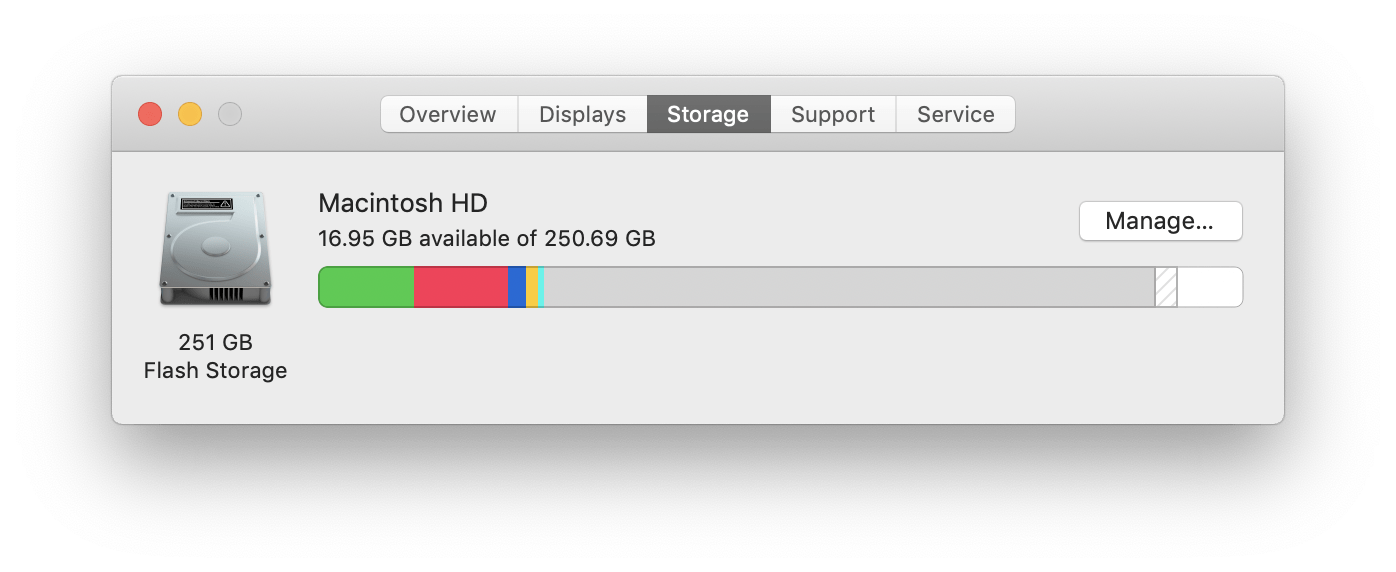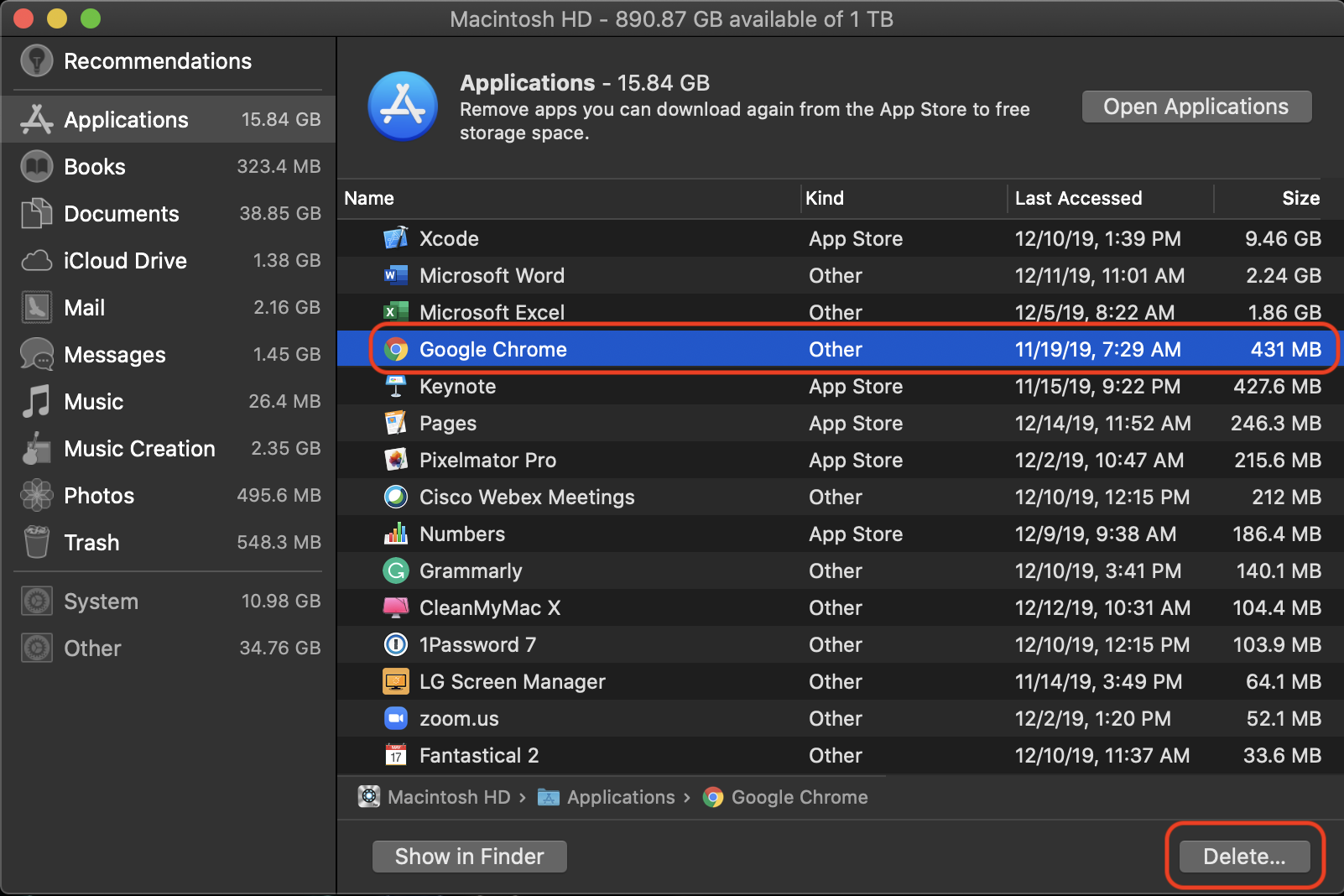The Optimized Storage features of your Mac help you save storage space by storing your content in iCloud and making it available on demand:
- When storage space is needed, files, photos, movies, email attachments, and other files that you seldom use are stored in iCloud automatically.
- Each file stays right where you last saved it, and downloads when you open it.
- Files that you’ve used recently remain on your Mac, along with optimized versions of your photos.
If you haven't yet upgraded to macOS Sierra or later, learn about other ways to free up storage space.
Find out how much storage is available on your Mac
System Storage Taking Up Way Too Much Space in macOS Sierra. I've encountered a problem on my brand new MacBook, but haven't been able to find a solution after working on it for most of today. In a nutshell: When I go to 'About This Mac Storage' the System files were taking up a whopping 90+ GB of my hard drive. Here is a screen shot. Backup the Mac computer with Time Machine. Check the available storage space on your Mac to ensure at least 30 GB available storage. Otherwise, you will need to remove some content from your Mac to clean up the storage space. If you don't have an idea how to clean up your Mac. Mac OS X: How to free up hard disk space By SK 5 comments Last updated July 24, 2017 This article describes several ways to free-up space on your Mac so that you can increase available space on your computer.
Choose Apple menu > About This Mac, then click Storage. Each segment of the bar is an estimate of the storage space used by a category of files. Move your pointer over each segment for more detail.
Click the Manage button to open the Storage Management window, pictured below.
Manage storage on your Mac
The Storage Management window offers recommendations for optimizing your storage. If some recommendations are already turned on, you will see fewer recommendations.
Store in iCloud
Click the Store in iCloud button, then choose from these options:
- Desktop and Documents. Store all files from these two locations in iCloud Drive. When storage space is needed, only the files you recently opened are kept on your Mac, so that you can easily work offline. Files stored only in iCloud show a download icon , which you can double-click to download the original file. Learn more about this feature.
- Photos. Store all original, full-resolution photos and videos in iCloud Photos. When storage space is needed, only space-saving (optimized) versions of photos are kept on your Mac. To download the original photo or video, just open it.
- Messages. Store all messages and attachments in iCloud. When storage space is needed, only the messages and attachments you recently opened are kept on your Mac. Learn more about Messages in iCloud.
Storing files in iCloud uses the storage space in your iCloud storage plan. If you reach or exceed your iCloud storage limit, you can either buy more iCloud storage or make more iCloud storage available. iCloud storage starts at 50GB for $0.99 (USD) a month, and you can purchase additional storage directly from your Apple device. Learn more about prices in your region.
Optimize Storage
Click the Optimize button to save space by automatically removing watched movies and TV shows. When storage space is needed, movies or TV shows that you purchased from Apple and already watched are removed from your Mac. Click the download icon next to a movie or TV show to download it again.
Your Mac will also save space by keeping only recent email attachments on this Mac when storage space is needed. You can manually download any attachments at any time by opening the email or attachment, or saving the attachment to your Mac.
Optimizing storage for movies, TV shows, and email attachments doesn't require iCloud storage space.
Empty Trash Automatically
Empty Trash Automatically permanently deletes files that have been in the Trash for more than 30 days.
Reduce Clutter
Reduce Clutter helps you identify large files and files you might no longer need. Click the Review Files button, then choose any of the file categories in the sidebar, such as Applications, Documents, Music Creation, or Trash.
You can delete the files in some categories directly from this window. Other categories show the total storage space used by the files in each app. You can then open the app and decide whether to delete files from within it.
Learn how to redownload apps, music, movies, TV shows, and books.
Where to find the settings for each feature
The button for each recommendation in the Storage Management window affects one or more settings in other apps. You can also control those settings directly within each app.
- If you're using macOS Catalina or later, choose Apple menu > System Preferences, click Apple ID, then select iCloud in the sidebar: Store in iCloud turns on the Optimize Mac Storage setting on the right. To turn off iCloud Drive entirely, deselect iCloud Drive.
- If you're using macOS Mojave or earlier, choose Apple menu > System Preferences, click iCloud, then click Options next to iCloud Drive. Store in iCloud turns on the Desktop & Documents Folders and Optimize Mac Storage settings.
- In Photos, choose Photos > Preferences, then click iCloud. Store in iCloud selects iCloud Photos and Optimize Mac Storage.
- In Messages, choose Messages > Preferences, then click iMessage. Store in iCloud selects Enable Messages in iCloud.
- If you're using macOS Catalina or later, open the Apple TV app, choose TV > Preferences from the menu bar, then click Files. Optimize Storage selects “Automatically delete watched movies and TV shows.”
- In you're using macOS Mojave or earlier, open iTunes, choose iTunes > Preferences from the menu bar, then click Advanced. Optimize Storage selects “Automatically delete watched movies and TV shows.”
- In Mail, choose Mail > Preferences from the menu bar, then click Accounts. In the Account Information section on the right, Optimize Storage sets the Download Attachments menu to either Recent or None.
Empty Trash Automatically: From the Finder, choose Finder > Preferences, then click Advanced. Empty Trash Automatically selects “Remove items from the Trash after 30 days.”
Other ways that macOS helps automatically save space
With macOS Sierra or later, your Mac automatically takes these additional steps to save storage space:
- Detects duplicate downloads in Safari, keeping only the most recent version of the download
- Reminds you to delete used app installers
- Removes old fonts, languages, and dictionaries that aren't being used
- Clears caches, logs, and other unnecessary data when storage space is needed

How to free up storage space manually
Even without using the Optimized Storage features described in this article, you can take other steps to make more storage space available:
- Music, movies, and other media can use a lot of storage space. Learn how to delete music, movies, and TV shows from your device.
- Delete other files that you no longer need by moving them to the Trash, then emptying the Trash. The Downloads folder is good place to look for files that you might no longer need.
- Move files to an external storage device.
- Compress files.
- Delete unneeded email: In the Mail app, choose Mailbox > Erase Junk Mail. If you no longer need the email in your Trash mailbox, choose Mailbox > Erase Deleted Items.
Learn more
- The Storage pane of About This Mac is the best way to determine the amount of storage space available on your Mac. Disk Utility and other apps might show storage categories such as Not Mounted, VM, Recovery, Other Volumes, Other, Free, or Purgeable. Don't rely on these categories to understand how to free up storage space or how much storage space is available for your data.
- When you duplicate a file on an APFS-formatted volume, that file doesn't use additional storage space on the volume. Deleting a duplicate file frees up only the space required by any data you might have added to the duplicate. If you no longer need any copies of the file, you can recover all of the storage space by deleting both the duplicate and the original file.
- If you're using a pro app and Optimize Mac Storage, learn how to make sure that your projects are always on your Mac and able to access their files.

If you’ve installed Xcode on your Mac and only just discovered how much space it’s taking up on your boot drive, you may be wondering why it’s so large. Or maybe you’ve tried to download it and got an error telling you that you don’t have enough space to install it and can’t work out why Xcode is so big. In this article, we’ll answer that question and also tell you what you can do to reduce the amount of space it takes up.
What is Xcode?
Xcode is Apple’s integrated development environment (IDE) for creating software for macOS, iOS, iPad IOS, and tvOS. It supports source code for the most popular languages, including Apple’s own Swift, C, C++, Objective-C, Objective-C++, Java, AppleScript, Python, and Ruby. It’s free to download from the App Store and can be used for most of the development process, including creating the user interface, writing code, compiling it, and then testing and debugging. Once it’s complete, Xcode can be used to submit apps to Apple’s App Store. That’s the only part of the process for which you will need to be a registered developer. If you want to use Xcode to learn new skills or improve existing ones, or just for fun, it’s free.
How much space does Xcode need?
On the App Store page for Xcode, it lists the size of Xcode 12.5 as 11.7GB. However, when you try and install it, you’ll get an error message unless you have at least 40GB of free space. However, that 40GB isn’t the full story. As you use Xcode, and specifically, as you connect more devices running different OS versions, Xcode will grow and grow in size and can easily take up much more than that 40GB. So, the answer to the question ‘how much space does Xcode need?’ is at least 40GB, but beyond that, it depends on how you use it.

Why is Xcode so large?
Xcode supports four different operating systems, iOS, iPad OS, macOS, and tvOS. And for each of those, it supports multiple versions. For each OS, it has simulator runtimes, libraries, compilers, and software development kits. It has a ton of data about declarations supported in each operating system. That’s why it’s so huge.
How To Find How Much Free Space On Mac
How to make Xcode take up less space
Every time you connect a device with a new version of an Apple OS running on it, even if it’s only a 0.1 upgrade, Xcode adds more data and grows larger. And many developers have noted that it never seems to remove any of that data. So Xcode continues to grow and grow. An effective way to reduce the amount of space Xcode uses is to remove the data associated with old versions of operating systems that you no longer need. However, that’s easier said than done. Here’s how to do it.
- In the Finder, navigate to the Go menu and choose Go to Folder.
- Type: ~/Library/Developer
- Look for the folder called iOS DeviceSupport and open it
- You will see it has separate folders for each version of iOS. Drag them all to the Trash.
- Look for the folder in ~/Library/Developer called iPad OS DeviceSupport and repeat step 4.
- Empty the Trash.
You should have removed several gigabytes of data. The next time you connect an iOS or iPad OS device and use Xcode, it will download the libraries it needs for the version of iOS or iPad OS the device is running. So there is no danger in removing those folders.
You can also remove devices and simulators you don’t need one at a time from within Xcode.
- In Xcode, click the Window menu.
- Choose Devices and Simulators.
- Click a simulator you want to remove and choose Delete.
You can also clear the cache associated with a project by opening the project and pressing Command + Shift +K. That will free up some space and fix any problems you are having with the project crashing.
An easier way to reduce the amount of space Xcode uses
CleanMyMac X has several tools that make it easy to free up space on your Mac. One of them is System Junk. It identifies files like language files you don’t use, user cache files, old updates, and other junk files put on your Mac by the system. Here’s how to use it.
- Download and install CleanMyMac X.
- Launch CleanMyMac X from your Applications folder.
- Choose System Junk and press Scan.
- When it’s finished, choose Review Details.
- Select Xcode Junk and press Clean.
Freespace Social Media Platform
When you select Xcode Junk, you’ll notice that to the right of its name, CleanMyMac X, tells you how much space will be cleared when you remove it. And in the right-hand window, you’ll see a list of folders and their sizes. CleanMyMac X is excellent at identifying what files can be safely removed, and you can keep its default settings without any concerns. However, you are always in control and can choose to keep specific files or folders.

Find Free Space On Mac
Xcode is an integrated development environment for creating software for macOS, iOS, iPadOS, and tvOS. It can be used to code in Swift, C, C++, Objective-C, Objective-C++, Java, AppleScript, Python, and Ruby. While the download size from the App Store is only just under 12GB, once you start using it, the amount of space it needs grows and grows. However, if you follow the steps above, you will be able to reduce that considerably. And if you use CleanMyMac X, it will be both quick and easy.